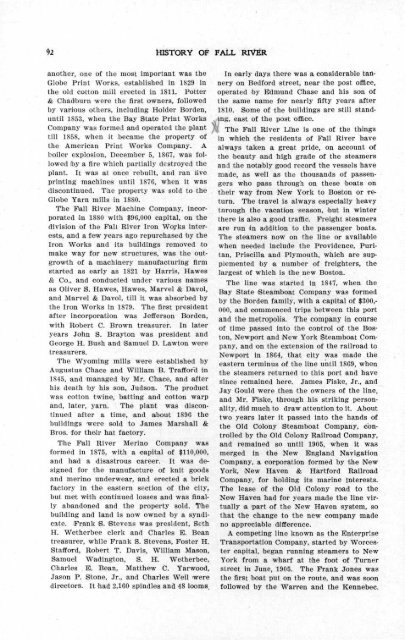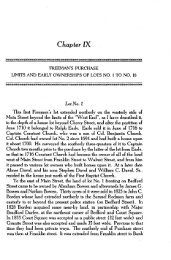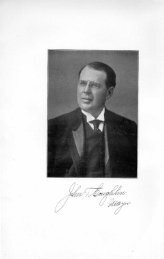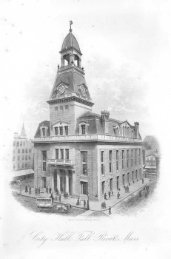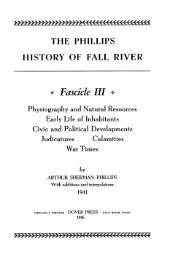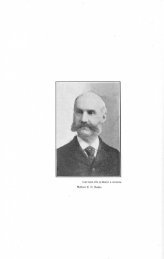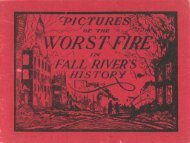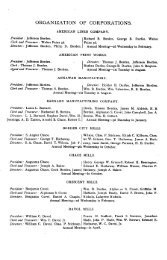Fall Rivers' Industries
Fall Rivers' Industries
Fall Rivers' Industries
Create successful ePaper yourself
Turn your PDF publications into a flip-book with our unique Google optimized e-Paper software.
92 HISTORY OF FALL RIVE R<br />
another, one of the most important was th e<br />
Globe Print Works, established in 1829 i n<br />
the old cotton mill erected in 1811 . Potte r<br />
& Chadburn were the first owners, followe d<br />
by various others, including Holder Borden ,<br />
until 1853, when the Bay State Print Work s<br />
Company was formed and operated the plan t<br />
till 1858, when it became the property o f<br />
the American Print Works Company . A<br />
boiler explosion, December 5, 1867, was fol -<br />
lowed by a fire which partially destroyed th e<br />
plant. It was at once rebuilt, and ran fiv e<br />
printing machines until 1876, when it wa s<br />
discontinued . The property was sold to th e<br />
Globe Yarn mills in 1880 .<br />
The <strong>Fall</strong> River Machine Company, incorporated<br />
in 1880 with $96,000 capital, on the<br />
division of the <strong>Fall</strong> River Iron Works interests,<br />
and a few years ago repurchased by the<br />
Iron Works and its buildings removed t o<br />
make way for new structures, was the out -<br />
growth of a machinery manufacturing fir m<br />
started as early as 1821 by Harris, Hawe s<br />
& Co., and conducted under various name s<br />
as Oliver S. Hawes, Hawes, Marvel & Davol ,<br />
and Marvel & Davol, till it was absorbed b y<br />
the Iron Works in 1879. The first president<br />
after incorporation was Jefferson Borden,<br />
with Robert C. Brown treasurer. In late r<br />
years John S. Brayton was president an d<br />
George H. Bush and Samuel D. Lawton were<br />
treasurers.<br />
The Wyoming mills were established b y<br />
Augustus Chace and William B. Trafford i n<br />
1845, and managed by Mr. Chace, and after<br />
his death by his son, Judson . The produc t<br />
was cotton twine, batting and cotton warp<br />
and, later, yarn. The plant was discontinued<br />
after a time, and about 1896 th e<br />
buildings were sold to James Marshall &<br />
Bros. for their hat factory .<br />
The <strong>Fall</strong> River Merino Company wa s<br />
formed in 1875, with a capital of $110,000 ,<br />
and had a disastrous career. It was designed<br />
for the manufacture of knit good s<br />
and merino underwear, and erected a bric k<br />
factory in the eastern section of the city ,<br />
but met with continued losses and was finally<br />
abandoned and the property sold . Th e<br />
building and land is now owned by a syndicate.<br />
Frank S. Stevens was president, Seth<br />
H. Wetherbee clerk and Charles E. Bea n<br />
treasurer, while Frank S. Stevens, Foster H .<br />
Stafford, Robert T. Davis, William Mason ,<br />
Samuel Wadington, S. H. Wetherbee ,<br />
Charles E. Bean, Matthew C . Yarwood ,<br />
Jason P. Stone, Jr., and Charles Weil wer e<br />
directors. It had 2,160 spindles and 48 loom s ,<br />
In early days there was a considerable tannery<br />
on Bedford street, near the post office,<br />
operated by Edmund Chase and his son of<br />
the same name for nearly fifty years afte r<br />
1810. Some of the buildings are still standing,<br />
east of the post office.<br />
The <strong>Fall</strong> River Line is one of the thing s<br />
in which the residents of <strong>Fall</strong> River hav e<br />
always taken a great pride, on account o f<br />
the beauty and high grade of the steamers<br />
and the notably good record the vessels hav e<br />
made, as well as the thousands of passengers<br />
who pass through on these boats on<br />
their way from New York to Boston or return.<br />
The travel is always especially heav y<br />
tnrough the vacation season, but in winte r<br />
there is also a good traffic . Freight steamer s<br />
are run in addition to the passenger boats .<br />
The steamers now on the line or available<br />
when needed include the Providence, Puri -<br />
tan, Priscilla and Plymouth, which are supplemented<br />
by a number of freighters, th e<br />
largest of which is the new Boston .<br />
The line was started in 1847, when th e<br />
Bay State Steamboat Company was formed<br />
by the Borden family, with a capital of $300, -<br />
000, and commenced trips between this por t<br />
and the metropolis. The company in cours e<br />
of time passed into the control of the Boston,<br />
Newport and New York Steamboat Company,<br />
and on the extension of the railroad t o<br />
Newport in 1864, that city was made th e<br />
eastern terminus of the line until 1869, whe n<br />
the steamers returned to this port and have<br />
since remained here. James Fiske, Jr., an d<br />
Jay Gould were then the owners of the line ,<br />
and Mr. Fiske, through his striking personality,<br />
did much to draw attention to it . Abou t<br />
two years later it passed into the hands of<br />
the Old Colony Steamboat Company, con -<br />
trolled by the Old Colony Railroad Company,<br />
and remained so until 1905, when it was<br />
merged in the New England Navigatio n<br />
Company, a corporation formed by the New<br />
York, New Haven & Hartford Railroad<br />
Company, for holding its marine interests .<br />
The lease of the Old Colony road to th e<br />
New Haven had for years made the line virtually<br />
a part of the New Haven system, s o<br />
that the change to the new company mad e<br />
no appreciable difference .<br />
A competing line known as the Enterpris e<br />
Transportation Company, started by Worcester<br />
capital, began running steamers to Ne w<br />
York from a wharf at the foot of Turne r<br />
street in June, 1905. The Frank Jones wa s<br />
the first boat put on the route, and was soo n<br />
followed by the Warren and the Kennebec .


